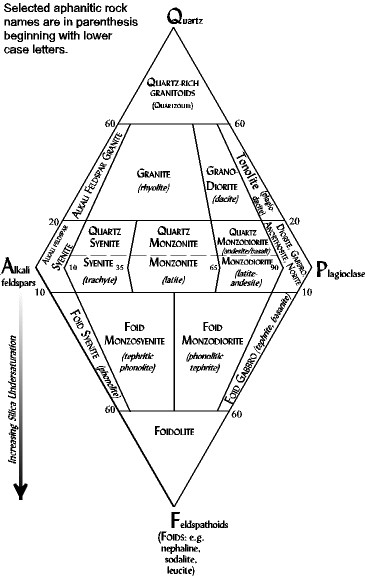
This process of building a larger molecule by the repeated addition of smaller molecules is known as polymerisation and the network itself is a polymer.Ī more polymerised magma will have a higher viscosity than a less polymerised magma. To construct the silicate network we must add silica tetrahedra to the framework, turning non-bridging oxygens into bridging oxygens.
#Igneous rock ternary diagram free
There are network formers (Si), bridging oxygens (O 0) and non-bridging oxygens (O -) making up the tetrahedra network, free oxygens (O 2-) that are not part of tetrahedra, and network modifiers that support and change the shape of the silicate network. The network in the melt contains many irregular rings and chains.Ītoms in the structure play the same roles as in silicate minerals. In silicate melts, however, the structure is more disordered, is flexible and can rearrange itself through the random motions of atoms and molecules. The structure of a silicate melt, like that of a silicate mineral, is formed by a 3D network of linked silica tetrahedra. If most of the grains are anhedral - that is they are generally not bounded by crystal faces, the fabric is said to be allotriomorphic granular. If most of the grains are subhedral - that is they bounded by only a few well-formed crystal faces, the fabric is said to be hypidiomorphic granular.ģ. The fabric is said to be idomorphic granular.Ģ. If most of the grains are euhedral - that is they are bounded by well-formed crystal faces. Three types of fabric are commonly referred to:ġ. Fabric refers to the mutual relationship between the grains. In a porphyritic texture, the larger grains are called phenocrysts and the material surrounding the the phenocrysts is called groundmass or matrix.Īnother aspect of texture, particularly in medium to coarse grained rocks is referred to as fabric. Single stage cooling can also produce a porphyritic texture. slow cooling to grow a few large crystals, followed by rapid cooling to grow many smaller crystals could result in a porphyritic texture, a texture with two or more distinct sizes of grains. A completely glassy texture is called holohyaline texture. The resulting texture will be glassy, with a few tiny crystals called microlites. Thus few crystals will form and they will not grow to any large size. If the size of the grains are so small that crystals cannot be distinguished with a hand lens, the texture is said to be aphanitic.Īt high degrees of undercooling, both the growth rate and nucleation rate will be low. This will result in many crystals all growing rapidly, but because there are so many crystals, they will run into each other before they have time to grow and the resulting texture will be a fine grained texture. Note that the rate of crystal growth and nucleation depends on how long the magma resides at a specified degree of undercooling (DT = Tm - T), and thus the rate at which temperature is lowered below the the crystallization temperature.Īt larger degrees of undercooling, the nucleation rate will be high and the growth rate also high. Shown below are hypothetical nucleation and growth rate curves based on experiments in simple systems.

First, nucleation and growth cannot occur until temperatures are below the temperature at which equilibrium crystallization begins. The crystal can then grow until it runs into other crystals or the supply of chemical constituents is cut off.Īll of these rates are strongly dependent on the temperature of the system. Once a nucleus forms, the chemical constituents must diffuse through the liquid to arrive at the surface of the growing crystal. In order for a crystal to form in a magma enough of the chemical constituents that will make up the crystal must be at the same place at the same time to form a nucleus of the crystal. This depends largely on the diffusion rate of the molecules of concern. The rate of growth of crystals - the rate at which new constituents can arrive at the surface of the growing crystal.The rate of nucleation of new crystals - the rate at which enough of the chemical constituents of a crystal can come together in one place without dissolving.The diffusion rate - the rate at which atoms or molecules can move (diffuse) through th liquid.The main factor that determines the texture of an igneous rock is the cooling rate (dT/dt). Extrusive rocks are usually distinguished from intrusive rocks on the basis of their texture and mineral composition.

By contrast, intrusive rocks are formed from magma that was forced into older rocks at depth within the Earth’s crust the molten material then slowly solidifies below the Earth’s surface, where it may later be exposed through erosion. Extrusive rock, any rock derived from magma (molten silicate material) that was poured out or ejected at the Earth’s surface.


 0 kommentar(er)
0 kommentar(er)
